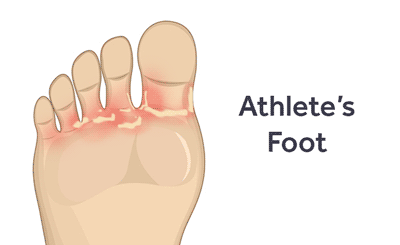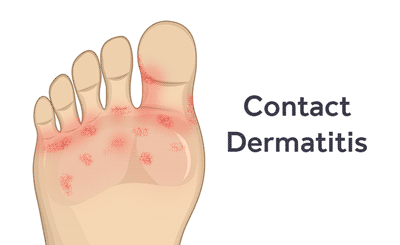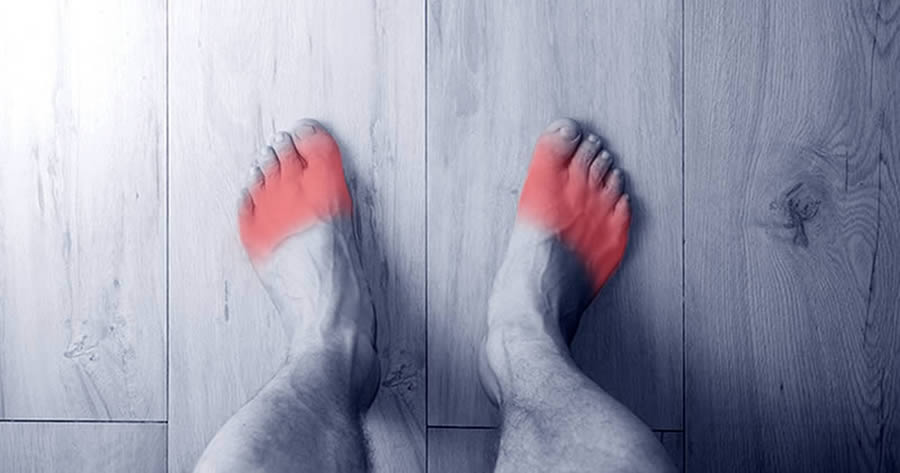Contact Dermatitis on Feet vs. Athlete's Foot
April happens to be National Foot Health Awareness month. It's also the time of year when many people dust off their running shoes to enjoy a sunny day outside. Unfortunately, that's also when foot problems tend to present themselves. Two common causes of irritated skin on your feet are athlete’s foot and contact dermatitis on feet. While both foot conditions have overlapping symptoms (and thus can be easy to misdiagnose), they result from very different causes.
It’s easy to take our feet, the foundational body parts that move us through our day, for granted. But if that foundation becomes red, itchy and irritated, then suddenly your feet will be all you’re able to think about. Let's walk through the symptoms, treatment and prevention tips for each. Then you'll be able to take proper steps to keep the skin on your feet healthy and irritation-free.
What is Athlete’s Foot?
Athlete’s foot (also called tinea pedis) is a surface fungal infection that irritates the skin on your feet. This type of fungus grows best in warm, moist conditions, such as the areas between the toes. It’s one of the most common fungal infections that affect humans, and it spreads easily. You can contract athlete’s foot by coming into contact with an infected person or with contaminated objects or surfaces. Locker room floors, towels and shoes are common culprits.
The condition can affect people of all ages, though it’s more common in adults than children. It's also more common in men than women. If you live in a humid climate or if you have a weakened immune system, you may be more at risk of contracting athlete’s foot. If you frequent areas where lots of people walk barefoot, such as swimming pools and locker room gyms, then you are at higher risk of infection.
The areas most likely to be affected by athlete’s foot are the spaces between your toes. The soles and tops of your feet can be affected too. The specific type of fungus that causes athlete’s foot will determine the exact symptoms and the impacted area of your foot. Common symptoms include redness, a scaly rash, itching, stinging and burning. More severe forms of athlete’s foot can cause very painful blisters and ulcers. The “moccasin” form of athlete’s foot, as it's called, causes severe dryness and scales on the soles and up the sides of your feet. This variety might most resemble contact dermatitis.

Prevention of Athlete’s Foot
Here are some steps you can follow to minimize the risk of getting athlete’s foot.
- Don’t wear tight-fitting athletic shoes that trap sweat against your skin. Such shoes create a perfect environment for fungi to thrive.
- Avoid walking barefoot in public, high-traffic areas where a lot of other people have been walking without shoes. This includes locker rooms, public showers, and public pool areas. (You can also get plantar warts from those environments. Here's our blog post about plantar wart self-care).
- Don’t share socks, shoes or towels with other people. It’s common on sports teams to borrow such items from each other. However, it’s best if you prepare ahead of time and keep back-up items in your locker or backpack so you don’t have to risk catching anything.
Take special care to follow prevention and treatment steps if you’re on an antibiotic. Antibiotic medications can kill off the beneficial skin bacteria that normally help control the fungus that causes athlete’s foot.
Treatment of Athlete's Foot
If you do contract a case of athlete’s foot then it is best to start treatment as soon as possible. There are many over-the-counter anti-fungal creams, sprays and powders that normally do the trick. The following tips can also help you to recover more quickly.
- Wear shoes that give your toes plenty of space and are made of breathable materials that allow good ventilation. (Ahem... such as Softstar's zero drop shoes for running).
- Wash and dry your feet (including between your toes) every morning and evening, especially if you’ve been physically active. Doing so deprives fungi of its ideal environment.
- If you are visiting public pools or showers, clean your footwear regularly.
- Change socks daily and after you’re physically active and sweating. Let shoes dry between uses if they’re sweaty or wet.
Additionally, if your skin is peeling, try not to peel and pick at it. You might create open sores that could expose you to a secondary type of infection.
If you have an advanced case of athlete’s foot, or if over-the-counter treatments aren’t working, then you should seek the advice of a medical professional. If anti-fungal medications aren’t eliciting improvement, it might also be a sign that you’re dealing with another type of condition such as contact dermatitis on your foot.
What is Contact Dermatitis?
Contact dermatitis is a response your skin has to a specific irritant or allergy. It's possible the irritant could be innocuous to other people, but still trigger a reaction for you. Unlike athlete’s foot, which is caused by common fungal strains, contact dermatitis may be caused by a wide number of sources ranging from soaps and fragrances to chemicals and certain types of metals. “Irritant” contact dermatitis can onset very quickly after coming into contact with the offending material. “Allergy” contact dermatitis may take up to a week for symptoms to appear.
Contact dermatitis occurs more frequently in adults than children. It can occur virtually anywhere on your body—wherever your skin comes into contact with the irritant or allergen. Contact dermatitis can certainly occur on your feet because they come into contact with many surfaces throughout the day. Warm weather, when you’re likely to be barefoot more often, increases risk.
If you notice contact dermatitis on your foot, symptoms may include:
- Redness
- Itchiness
- A patchy or scaly rash
- Dry and cracked skin
- Bumps and blisters
- Swelling
- Burning
- Tenderness

In some cases, Contact dermatitis may be a reaction to chemicals and materials commonly used in footwear. In athletic shoes, for instance, dyes used in soling material have been known to cause contact dermatitis in some people. If you are allergic or sensitive to shoe chemicals, the warm, damp conditions inside your shoe can exacerbate the issue. This can lead to rash-like symptoms on the skin that could appear similar to the symptoms of athlete’s foot.
Prevention of Contact Dermatitis on Feet
You’ll want to eliminate exposure to common irritants to determine what triggered the initial reaction. It's like going on an elimination diet to determine whether you have a food allergy. They following tips could help you to help prevent contact dermatitis on your foot by getting to the root cause.
- Consider all substances your feet have come into contact with in recent days. For instance, what creams, lotions, body washes or soaps have you used? Try eliminating them or switching to all-natural, unscented versions.
- Consider all surfaces you’ve walked on and what cleaners have been used on those surfaces. The chemicals or fragrances in cleaning products could be a source of irritation for you.
- Consider the laundry soap used to wash your socks. Like floor cleaners, the fragrances or other ingredients used in the soap could be the culprit.
- Determine whether your feet have come into contact with any metals. Nickel, for example, is a common irritant. Consider clasps and buckles on shoes that may come into contact with your skin.
- Rule out whether your feet have come into contact with any new plants known to cause contact dermatitis. Poison oak, for example.
Treatment of Contact Dermatitis on your Foot
- Consider switching to footwear made with natural materials such as Softstar’s soft leather minimalist shoes. Doing so can eliminate potential irritants posed by synthetic materials and the high-chemical manufacturing processes of most commercial footwear. For an extra level of chemical-free "naked" leather, check out the Vegetable-Tanned leather options available on certain customizable styles.
- For athletes, athletic tape may be an irritant, especially if the product contains rubber or latex. If you tape your fee frequently then you may want to try switching brands or types of tape.
- Ironically, an overuse of antifungal creams applied to treat athlete’s foot can actually cause contact dermatitis in certain individuals. If you try an antifungal cream and it doesn’t help, seek the advice of a medical professional.
- Your doctor may recommend treatment such as corticosteroids or antihistamines.
The most obvious form of treatment for contact dermatitis is simply avoiding coming into contact with irritants (see "Prevention," above). You can also try using cold compresses to help with the immediate symptoms of burning and itching of your feet.
Overall Foot Health Tips
Carefully consider your symptoms, the surfaces, and the substances your feet have come into contact with. Then you can consider next steps. Whether you have a case of athlete’s foot or contact dermatitis on your feet, we always recommend the following tips.
- Practice good foot hygiene
- Avoid high-germ areas
- Use natural products free of dyes and synthetic fragrances
- Treat your feet to the good life by wearing breathable socks and natural footwear
While we are shoemakers who are passionate about foot health, we are not doctors and cannot prescribe medical advice. We recommend you consult your health care practitioner to develop a treatment plan for any foot condition.

Shelley Stonebrook is a writer and editor who is passionate about the outdoors and environmental advocacy. She lives and gardens with her husband and daughter in Corvallis, Oregon.


6 Comments